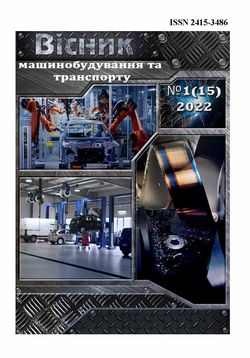Ensuring handling of passenger cars in the event of combined braking on a curve road section
DOI:
https://doi.org/10.31649/2413-4503-2022-15-1-116-123Keywords:
passenger car, handling, braking, curvilinear trajectory, combined braking methodAbstract
The article deals with the problem of ensuring the controllability of a passenger car equipped with electronic systems for tracking the braking process, moving along a curved trajectory when braking in a combined way, taking into account the lateral input of the wheels of both axles.
A hypothesis is proposed to ensure the controllability of passenger cars moving along a curvilinear trajectory in a braked state without breaking the transmission by taking into account the relative decrease in the realized engine power.
The authors obtained criterion dependencies that will allow creating new algorithms for the functioning of modern electronic control systems for stabilizing the longitudinal axis of a braked car, taking into account the change in lateral forces in the contact of the wheels with the supporting surface, due to the appearance of centrifugal inertia force, which, with a certain combination of a linear car during braking, can cause lateral sliding front or rear axle.
It has been established that with an increase in the angular velocity of turn and a decrease in the angle of lateral entry of the longitudinal axis of the car during braking and the angle of rotation of the steered wheels, the controllability of the car increases. In addition, the controllability of a passenger car increases with an increase in the radius of curvature of the trajectory of movement, a decrease in the angular velocity of the steering wheel, and with an increase in the initial speed and braking distance of the car, it decreases.
Criteria equations are obtained for assessing the controllability of a car during emergency braking in a turn by a combined method that relates the angle of deviation of the longitudinal axis of the car with the braking distance and the rate of change in the average angle of rotation of the steered wheels.
To ensure the controllability of the passenger car in this case, the derivatives of the angle of deviation of the longitudinal axis of the car along the braking distance and the average angle of rotation of the steered wheels should approach a minimum.
References
Л. В. Михалева, О. В. Алексеева, О. С. Гасилова, Б. А. Сидоров «Результаты определения минимально безопасного расстояния между легковыми автомобилями, движущимися в попутном направлении», Изветсия ТУЛГУ. Технические науки, вып. 4, с. 214-219, 2011.
Колісні транспортні засоби. Вимоги щодо безпечності технічного стану та методи контролювання (БЗ №11-12-2010/436): ДСТУ 3649: 2010. – Офіц. вид. – [Чинний від 28.11.2010]. К.: Держспоживстандарт України, 2011. 26 с. – (Національний стандарт України).
Динамика транспортных средств. ESP. [Электронная программа стабильности]. Режим доступа:
https://translate.google.com.ua/translate://www.car-engineer.com/esp-electronic-stability-program.
И. В. Ходес, А. С. Никитин, «Влияние координаты центра массы на эффективность тормозной динамики двухосного автомобиля», Известия ВОЛГГТУ, вып. 5, т. 2, с. 41-44, 2012.
Д. А. Соснин, В. Ф. Яковлев, Новейшие автомобильные электронные системы. М.: СОЛОН-Пресс, 2005, с. 167-184 с.
А. А. Бобошко, «Оценка предельных по условиям сцепления колес с дорогой показателей управляемости автомобилей и тракторов», Автомобильный транспорт, вып. 7, с. 92-94, 2001.
В. Г. Вербицкий, В. П. Сахно, А. П. Кравченко, Автомобили. Устойчивость. Донецк-Киев-Луганск: Ноулидж, 2013. 176 с.
А. И. Сафонов, «О развитии тормозных систем» Вестник машиностроения. – М.: Машиностроение, № 12, с. 37-44, 2011. – ISSN 0042-4633.
Л. Я. Лагунов, Г. С. Прохорова, «Влияние эффективности торможения на повороте на пропускную способность дороги» Автомобильный транспорт. Киев: Техника, вып. 19, с. 111-116, 1982.
І. О. Назаров, В. І. Назаров, «Вплив експлуатаційних умов на ефективність гальмування легкових автомобілів», у Міжвузівський збірник. Наукові нотатки, Луцьк: ЛНТУ, 2014, вип. 56, с. 119-127.
Я. С. Агейкин, Н. С. Вольская, Теория автомобиля [Электронный ресурс]. М.: МГИУ, 2008, 318 с. – Режим доступа: http:/www.books.google.com.ua/books
Downloads
-
PDF (Українська)
Downloads: 211



